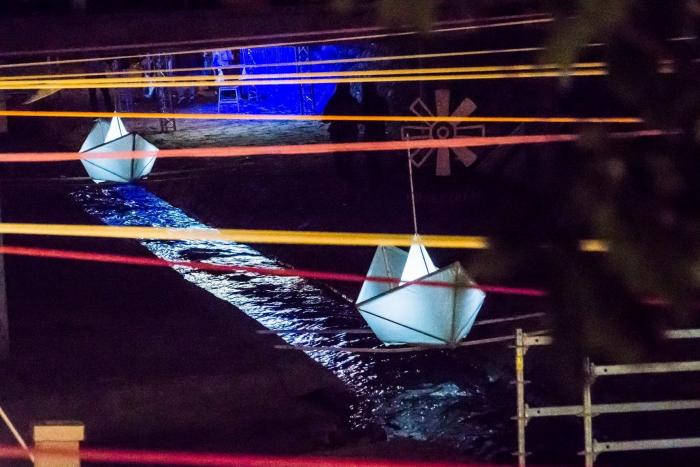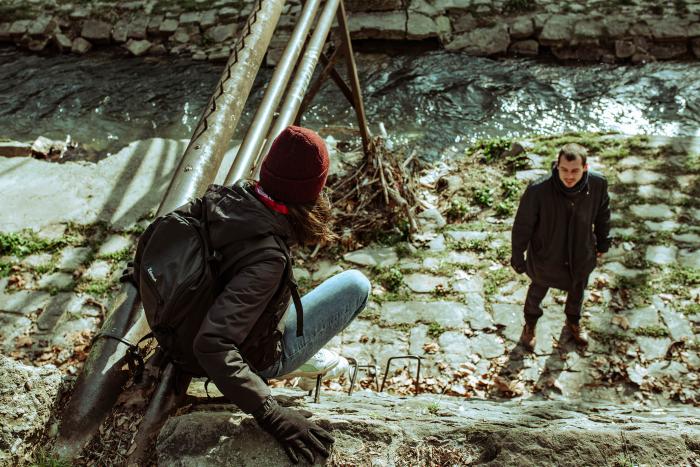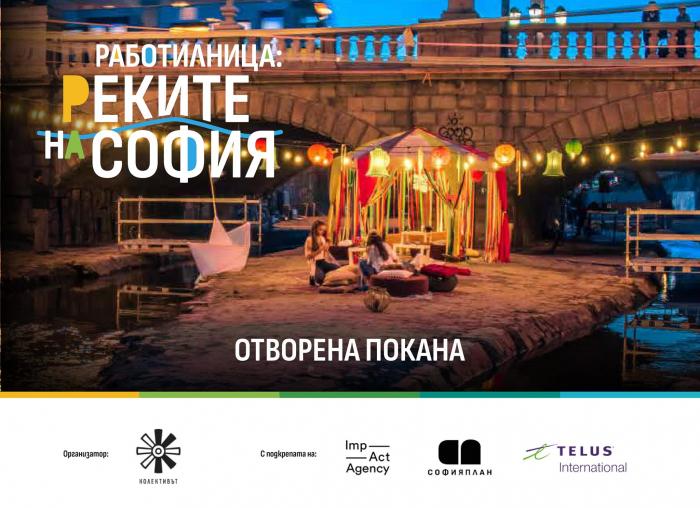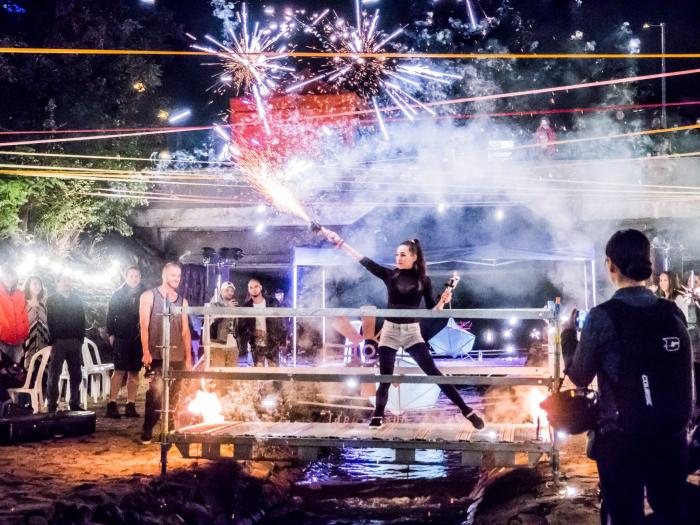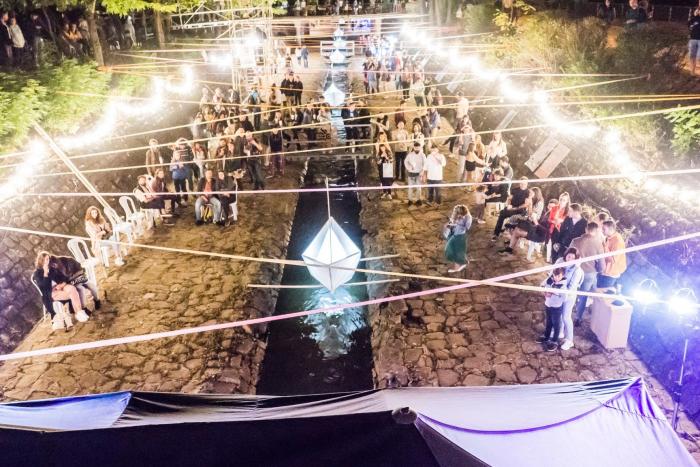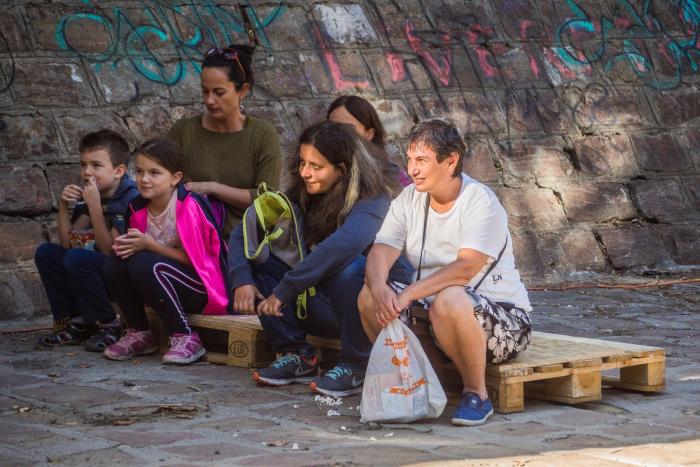I. SUMMARY INFORMATION
Project
268053
Status
Submitted
Award category
Regenerated urban and rural spaces
You want to submit
NEW EUROPEAN BAUHAUS AWARDS : existing completed examples
Project title
The Rivers of Sofia
Full project title
The Rivers of Sofia: connecting the rivers to the city and its people
Description
Sofia’s urban riverbanks have potential to develop as public spaces, but remain inaccessible and suffer from poor upkeep. The Rivers of Sofia Festival aimed to catalyse change by transforming the rivers and changing people’s perception of them. With light architectural interventions and a cultural programme that engaged diverse social groups, the rivers turned into thriving public space. The Rivers of Sofia has since turned into a platform for collective urbanism and is leading long-term change.
Where was your project implemented in the EU?
Bulgaria
Sofia
Eagle Bridge; Lions Bridge; Perlovska River in the area in front of Vasil Levski Stadium
Sofia
1000
When was your project implemented?
Has your project benefited from EU programmes or funds?
No
Which programme(s) or fund(s)? Provide the name of the programme(s)/fund(s), the strand/action line as relevant and the year.
II. DESCRIPTION OF THE PROJECT
Please provide a summary of your project
The Rivers of Sofia Festival took place in Sep 2020 at three locations on two rivers crossing Sofia’s centre. The riverbanks have been inaccessible for decades, but they have potential to develop as green public spaces or linear parks. These ideas were proposed in the report Sofia: Public spaces and social life by Jan Gehl in 2017. However, people are not used to seeing the rivers as public space, and no civic actions have been directed towards that goal so far.
Our project aimed to catalyse change by temporarily transforming the rivers and changing people’s perception. With light architectural interventions and a cultural programme that engaged diverse social groups, the rivers turned into thriving public space.
The Rivers of Sofia Festival cost under 25000 EUR to realise and the funds were secured from private sponsors. We installed access points made of scaffolding as well as temporary stages and pavilions, and we decorated the space with lights, fabric, and art installations. This instant architecture transformed the space and the riverbanks became lively spaces for culture, sport and recreation.
6000 people visited - a significant number, given that these spaces were inaccessible and unusable before. Over 100 media outlets reported on the project. An engaged online audience follows us, and we plan a second iteration of the festival in September 2021.
Our goal was to use architecture and collective celebration to generate momentum for urban change. The temporary intervention has indeed started a process of permanently transforming the rivers. After the festival’s success, the municipal Architecture and Urbanism office approved a proposal for semi-permanent interventions including access stairs, vertical gardens and seating. Meanwhile, we are forging more partnerships with like-minded organisations and collaborating with schools to involve youth in further projects. Thus, we proved our concept that instant architectural interventions can spark lasting change.
Please give information about the key objectives of your project in terms of sustainability and how these have been met
This was a project with a light ecological footprint, as the intervention consisted of temporary structures that were assembled within days and disassembled to be reused later. The largest structures on-site were the access stairs made of standard industrial scaffolding. Temporary stages were made of wooden slats, and pavilions and tents - from poles and cloth. These light, movable structures present a simple solution for transforming spaces in a sustainable way, without altering the natural or built environment. The festival also succeeded in using cultural and commercial resources available within the city: local artists, performers, and small businesses helped make it happen, with no travel necessary. We channeled the talent and creativity available within our city for maximum aesthetic and social impact.
The project was sustainable in another sense, too: in terms of sparking long-term change, including social sustainability. Since the festival, we have maintained an engaged online audience, continued an open dialogue with the responsible authorities, and expanded our network of partnerships with NGOs, educational and cultural institutions, municipal bodies, and businesses. We held a workshop including university students and Sofia’s Chief Architect to create long-term solutions to integrate Sofia’s rivers into the urban fabric and turn them into green public spaces. The workshop was widely publicised, and an open discussion (held online due to the pandemic) engaged more people. The semi-permanent interventions designed at the workshop received positive responses from the city’s Architecture and Urbanism office, and after initial approval, we submitted complete technical projects so they can be realised. Thus, The Rivers of Sofia expanded and is growing sustainably so we can connect the city’s natural resources with the urban fabric and its people. We continue to build community around the initiative and to involve various stakeholders.
Please give information about the key objectives of your project in terms of aesthetics and quality of experience beyond functionality and how these have been met
Light temporary structures were used to integrate the rivers into the city fabric. We connected the riverbanks to the street level above, opened up public space by the water, and bridged the two banks to turn them into a unified space with uninterrupted foot traffic and continuous gatherings on both sides.
One of the locations, on the Perlovska River, offered a more active promenade with various shows on the many temporary bridges. These bridges/stages were low and close to the ground, level with the two banks on which people were observing the performances or percolating. Pavilions were suspended over the river, in an imaginative act of reclaiming more public space and bringing people close to the water. Between the bridges and pavilions, ‘paper ship’ sculptures made of white cloth stretched over wooden bars and lit up from inside were suspended over the water, creating the illusion of floating on it. This turned the canal from a place citizens perceive as dirty and off-limits to a space of play and celebration.
The design on Vladaiska River created a cozier space for relaxation. In an open tent, ottomans arranged in a circle provided soft seating and a space to meet or relax. Ribbon hanging down from the rim of the tent created a permeable barrier between inside and outside, inviting people in while also allowing for relative seclusion and conversation. More ottomans, carpets, and tables were placed directly onto the riverbank, with lanterns hanging above. Those immediately transformed the uncomfortable surface of roughly hewn stone into an inviting, cozy space. Curtains were hung under a traffic bridge across the river, further creating the illusion of a home-like interior in an otherwise barren area defined by bare stone and concrete. An open-air bazaar created a space for slower circulation and observation.
The festival turned the two rivers into promenades with performances, activity booths, and chill-out areas to enjoy along the way.
Please give information about the key objectives of your project in terms of inclusion and how these have been met
The festival was conceived with inclusion in mind, as the goal was to create a temporary but fully functional public space that would be open and welcoming to diverse social groups. In terms of design, we defined areas for active participation and for relaxation so people would be able to engage in the way they preferred, depending on their age, interests, neurodiverse status, etc. Further, the range of activities was devised so that various segments of Sofia’s population would be able to take part. Throughout the day, the festival included outdoor sports, games for children, and family-friendly activities. At one of the locations, we also created an outdoor bazaar as an extension of Zhenski Pazar - a traditional market at the heart of Sofia’s most diverse neighbourhood. This created the sense that the market continued on the riverbank, connecting the festival to its context and drawing in local people. Members of the surrounding communities did visit and take part in the activities -- typically, in this area there is no programming that targets the whole community and brings Roma, Arab and Bulgarian people together. Our outreach campaign was also directed towards different groups - young people, families, and locals living close to the festival areas, as well as various interest groups. Thanks to our communication strategy, design, and programming, the festival was an inclusive event that brought together 6000 of the city’s residents of various ages and backgrounds to create a broadly shared sense of public space.
After the shared celebration gave the campaign a strong start, The Rivers of Sofia continues to function as a platform for creating inclusive spaces and involving more people in decision-making about the city. The festival and later actions showed people that change is possible even in the most problematic areas of the city and that, with some imagination, a small budget, and a positive attitude, we can improve our environment to the benefit of all.
Please give information on the results/impacts achieved by your project in relation to the category you apply for
The Rivers of Sofia festival regenerated some of the most inaccessible and rundown areas in Sofia’s centre - the artificial riverbanks, which were constructed out of roughly hewn stone over a century ago. The structures have not undergone significant change since then. Sofia’s rivers are part of the city’s vital resources: they could be a place for people to enjoy quiet and greenery and take a walk, as well as to gather for civic and cultural activities. As they traverse the whole city, the rivers could be further developed into linear parks as part of a green urban network providing an alternative to car traffic. In spite of this huge potential, the canals have remained inaccessible and gradually fall into ruin. Instead of connecting areas of the city and the communities that live alongside them, they turn into barriers: the rivers are difficult to cross, and they isolate neighborhoods from each other.
The Rivers of Sofia has succeeded in showing that the seemingly impossible regeneration of the rivers is easily achievable with targeted actions that gather community and momentum for change. After this successful beginning, the alliance of stakeholders aiming to revitalise the rivers to the benefit of all has only grown stronger. Over 30 organisations supported the festival, including NGOs, art galleries, and local businesses. Since then, we have forged more partnerships with educational institutions and municipal authorities, continued to grow our public outreach, and held workshops that develop The Rivers of Sofia as a platform for citizen education through collective placemaking.
The positive reviews and strong public support the project received led the city’s Architecture and Urbanism office to grant initial approval for semi-permanent installations in the same spaces, including access stairs, greenery, and seating. Thus, our tactical intervention successfully planted the seeds of longer-term revitalisation of these abandoned spaces.
Please explain the way citizens benefiting from or affected by the project and civil society have been involved in the project and what has been the impact of this involvement on the project
The project happened thanks to over 40 volunteers who helped construct the temporary architectural interventions and coordinate events during the festival. We also closely collaborated with local artists, from graffiti painters to circus performers and local bands, to create the programme. Volunteers received training in practical placemaking strategies and many have remained involved since, becoming a part of The Collective Foundation and our growing campaigns for public space. For artists, the festival was a chance to both reach a significant audience and use their art to spark change in the urban environment.
The festival was open to the wider public and attracted an average of 3000 people per day. The vast majority of visitors were stepping onto the riverbanks for the first time, as these spaces had not been accessible before. Thus, the festival was an important act of reclaiming public space by means of public involvement. Visitors took part in inclusive activities like a shared neighbourhood meal and games for children. Dozens of people who had a positive experience at the festival have written to us, and some have become collaborators and volunteers in subsequent actions. We also maintain an engaged social media following, enabling us to scale future events and reach even more people.
As The Rivers of Sofia grows as an initiative, we are engaging citizens in new ways. After our workshop with university students to devise solutions for the rivers that were submitted to the Chief Architect, we have now, on 28-30 May 2021, just completed our first workshop with high school students from under-resourced schools, who took an active part in changing their urban environment. The hands-on, inclusive workshop empowered youth to put their ideas into action and connected them with local officials so that their designs would be realised. We are combining placemaking with civic education and teaching social entrepreneurship through architecture and design.
Please highlight the innovative character of the project
The project’s innovation is to use temporary, tactical architectural interventions to spark lasting change. We targeted spaces that have remained rundown for years, while larger projects for their revitalisation have stalled. We showed that temporary designs with wide civic involvement can contribute more towards revitalising a space than detailed projects on paper, which Sofia’s municipal authorities have had for years with little effect. Once the momentum and public support is there, change is much easier. We devised a way of using minimum means with maximum impact: cheap, mass-produced materials and modular structures were deployed in a way that completely altered the character and function of some of the most rundown spaces in Sofia’s centre. For a tiny fraction of the budget needed to permanently repair the riverbanks, we created a strong aesthetic concept, involved local artists, small businesses, and citizens, and generated broad publicity and support - so that when the rivers are finally restored, the social infrastructure to turn them into thriving public spaces will already be there.
We have shown the importance of building community around a project and using the power of aesthetic impact to bring about long-term change. Temporary art installations and urban festivals can be treated as urbanist projects -- even if they will disappear later, the impact remains, especially if wide public support and involvement from different stakeholders is secured. This method can be used to make urban development broadly understood and to engage citizens. The Rivers of Sofia showed how we can bring architectural and social development and the arts together as part of the same process of citymaking to the benefit of all.
Please explain how the project led to results or learnings which could be transferred to other interested parties
Events, art installations, and urban festivals are not typically thought of as urbanist initiatives, but they can showcase architectural solutions in temporary form, while also involving the community and generating wide participation and support. This idea could be applied in any European city, but especially in so-called “civic deserts” with low public involvement, where seeing tangible change can have an even bigger impact on citizens.
We hope architects, designers and urbanists across Europe would be inspired by our project and use temporary interventions and celebrations like The Rivers of Sofia to involve citizens in a process of dreaming up and building what previously seemed impossible.
We have learned that, once people see positive change in their environment, many more are willing to get involved. We challenge architects across Europe to hold design-build workshops for youth or citizens of all ages and to see the civic potential that is unleashed when people work on redesigning their environment together. Temporary projects allow even more room for imagination and bold ideas, and those ideas can turn into sustained campaigns for broader change. Tactical, inclusive urban interventions as a means to achieve greener cities with more public space: let’s do it!
Is an evaluation report or any relevant independent evaluation source available?
No
III. UPLOAD PICTURES
IV. VALIDATION
By ticking this box, you declare that all the information provided in this form is factually correct, that the proposed project has not been proposed for the Awards more than once under the same category and that it has not been subject to any type of investigation, which could lead to a financial correction because of irregularities or fraud.
Yes
